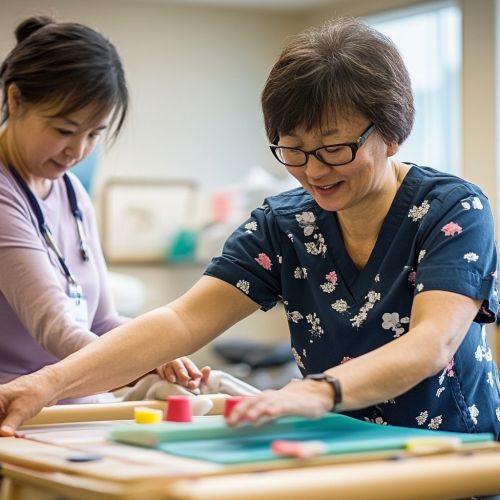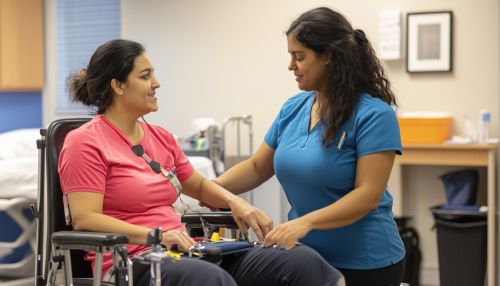Cognitive Mechanisms in Cognitive Rehabilitation
Cognitive Mechanisms in Cognitive Rehabilitation
Cognitive rehabilitation is a therapeutic approach aimed at improving cognitive functions that have been impaired due to brain injury, neurological disorders, or other conditions. This article delves into the cognitive mechanisms that underpin cognitive rehabilitation, exploring the processes and strategies employed to enhance cognitive recovery.


Introduction
Cognitive rehabilitation involves structured interventions designed to improve cognitive deficits and enhance the overall quality of life for individuals affected by cognitive impairments. These interventions are grounded in an understanding of the brain's cognitive mechanisms, which include processes such as attention, memory, executive function, and language.
Attention
Attention is a fundamental cognitive mechanism that plays a crucial role in cognitive rehabilitation. It involves the ability to focus on specific stimuli while ignoring others, and it is essential for performing daily tasks. Attention can be divided into several subtypes:
- **Selective Attention**: The ability to focus on a specific task or stimulus while ignoring irrelevant information.
- **Sustained Attention**: The capacity to maintain focus over an extended period.
- **Divided Attention**: The ability to process multiple stimuli or tasks simultaneously.
Interventions targeting attention often involve exercises designed to improve these specific types of attention. For example, tasks that require patients to identify target stimuli among distractors can enhance selective attention.
Memory
Memory is another critical cognitive mechanism addressed in cognitive rehabilitation. Memory can be categorized into different types, each playing a unique role in cognitive functioning:
- **Short-Term Memory**: The ability to hold and manipulate information for a brief period.
- **Long-Term Memory**: The storage of information over an extended period, which includes episodic, semantic, and procedural memory.
- **Working Memory**: A type of short-term memory that involves the temporary storage and manipulation of information necessary for complex cognitive tasks.
Memory rehabilitation techniques often include mnemonic strategies, spaced retrieval, and the use of external aids such as calendars and notebooks to compensate for memory deficits.
Executive Function
Executive function encompasses a range of cognitive processes that enable goal-directed behavior, problem-solving, and decision-making. Key components of executive function include:
- **Planning**: The ability to set goals and develop strategies to achieve them.
- **Inhibition**: The capacity to suppress inappropriate responses or behaviors.
- **Cognitive Flexibility**: The ability to switch between tasks or adapt to changing circumstances.
- **Working Memory**: As mentioned earlier, this is also a component of executive function.
Cognitive rehabilitation for executive function often involves tasks that require patients to plan, organize, and execute complex activities. Techniques such as goal management training and problem-solving therapy are commonly used.
Language
Language is a vital cognitive mechanism that can be affected by brain injury or neurological disorders. Language rehabilitation focuses on improving various aspects of language, including:
- **Speech Production**: The ability to articulate words and sentences.
- **Comprehension**: The capacity to understand spoken and written language.
- **Reading and Writing**: Skills related to decoding and producing written text.
Therapies for language rehabilitation may include speech therapy, language exercises, and the use of augmentative and alternative communication devices.
Neuroplasticity
Neuroplasticity refers to the brain's ability to reorganize itself by forming new neural connections. This mechanism is fundamental to cognitive rehabilitation, as it underlies the brain's capacity to recover from injury and adapt to new challenges. Neuroplasticity can be enhanced through targeted cognitive exercises and activities that stimulate neural pathways.
Cognitive Rehabilitation Strategies
Several strategies are employed in cognitive rehabilitation to leverage these cognitive mechanisms:
- **Restorative Approaches**: These aim to restore lost cognitive functions through repetitive practice and exercises.
- **Compensatory Approaches**: These involve teaching patients to use alternative strategies or tools to compensate for cognitive deficits.
- **Metacognitive Approaches**: These focus on improving patients' awareness and regulation of their own cognitive processes.
Technology in Cognitive Rehabilitation
Advancements in technology have significantly impacted cognitive rehabilitation. Computer-based cognitive training programs, virtual reality, and mobile applications provide innovative ways to deliver cognitive exercises and track progress. These technologies can offer personalized and adaptive interventions that cater to individual needs.
Challenges and Future Directions
Despite the progress in cognitive rehabilitation, several challenges remain. These include the need for more robust evidence supporting the efficacy of specific interventions, the variability in patient responses, and the integration of cognitive rehabilitation into standard clinical practice. Future research is likely to focus on identifying biomarkers for cognitive recovery, developing more effective interventions, and exploring the potential of emerging technologies.
Conclusion
Cognitive rehabilitation is a dynamic and evolving field that leverages an understanding of cognitive mechanisms to improve the lives of individuals with cognitive impairments. By targeting attention, memory, executive function, and language, and harnessing the power of neuroplasticity, cognitive rehabilitation offers hope for recovery and adaptation.
